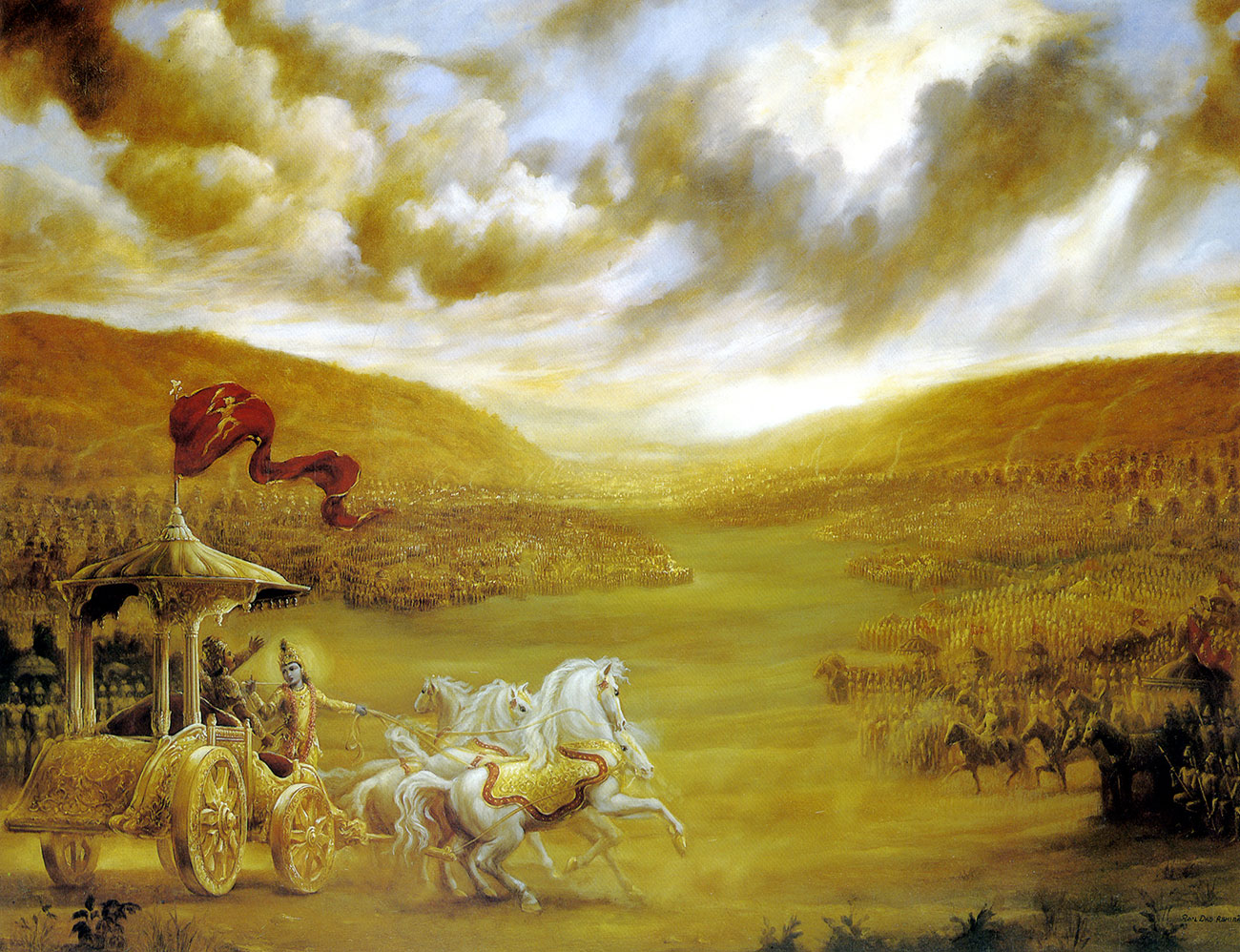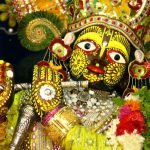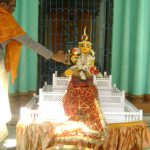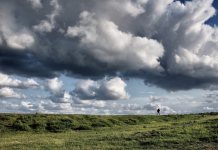by Swami B. A. Ashram
Most readers of Bhagavad-gita may be acquainted with the historic setting of the discourse. As the result of a life-long power struggle between two sets of cousins, the Pandavas and the Kauravas, who were all raised as brothers, we find ourselves on the brink of an enormous fratricidal war, as narrated in the great epic poem Mahabharata. Of the two sides, the Kauravas have fallen under the influence of personal ambition and have sought to usurp control of the kingdom from the pious, devotional Pandavas, who are Krsna’s cousins and personal friends. One of the Pandava brothers, Arjuna, whom Krsna has agreed to serve as his chariot driver, has asked Krsna to drive his chariot between the opposing armies just as the fighting is to begin, so he can see just who it is he must fight and ultimately kill. The first verse opens the Gita with the Kauravas’ father, the blind Dhrtarastra, asking the sage Sanjaya to tell him what is happening just at this moment.
dhrtarastra uvaca
dharma-ksetre kuru-ksetre
samaveta yuyutsavah
mamakah pandavas caiva
kim akurvata sanjaya
Dhrtarastra said: What did my sons and the sons of Pandu do as they assembled at sacred Kuruksetra, eager to fight?
Many readers may be familiar with this verse; they may even have it memorized. I wonder, though, how many have considered the breadth of philosophy, particularly Gaudiya Vaisnava philosophy, this verse suggests. Careful examination of this verse in three parts may yield profound philosophical implications, even show how it sets the tone for the entire Gita itself.
When we examine the first phrase, dharma-ksetre kuru-ksetre, which comprises the verse’s first pada, or metrical foot, we find that it works brilliantly to create the setting for the conversation between Lord Krsna and his friend and devotee Arjuna, not just geographically, but metaphysically. Characterizing the battlefield with the phrase dharma-ksetre conveys considerable meaning. Srila A. C. Bhaktivedanta Swami Prabhupada, for example, points out that dharma-ksetre indicates a place where religious rituals are performed. That is a significant point, he says, because here at Kuruksetra Krsna is present on Arjuna’s side as the armies prepare for battle. Moreover, the pious influence of the setting seems to augur ill for the prospects of Dhrtarastra’s sons, the Kauravas. Swami B. V. Tripurari, following other commentators, especially Visvanatha Cakravarti Thakura, points out that Dhrtarastra doubted that his sons would prevail in the impending war. But the pious nature of the field, he thought, perhaps a little too hopefully, might influence the virtuous Pandavas to desist from fighting, offering the Kauravas a victory by default.
Why, though, did that not turn out to be the case? Many Gaudiya commentators, including Visvanatha Cakravarti, Baladeva Vidyahusana, and Srila Prabhupada, point to another way the pious nature of this dharma-ksetre might have made Dhrtarastra uneasy. The image of a field, they point out, evokes the need to distinguish between the rice and the weeds, with the implication that the weeds will be pulled out, so the rice can thrive.
Dharma here may also foreshadow the range of the discussion about to take place between Arjuna and Krsna. As Swami Tripurari writes in his commentary, “Bhagavad-gita takes us on a religious and spiritual journey from selfishness to selflessness in love of God.” We’ll examine the depth of selfishness apparent here when we examine another phrase later in the verse. But one thing we know is that Krsna and Arjuna will discuss dharma from a number of angles, ranging from conventional concepts of dharma, such as karma kanda and varnasrama dharma, to the ultimate dharma, which is love of God, Krsna prema. So even here, in the first word of the Gita, we are given a glimpse of the Gita’s last word. As we may know, Krsna’s final instruction in Bhagavad-gita is to absolutely reject all conventional dharma and take exclusive shelter of Krsna:
Abandon all varieties of religion and just surrender to Me. I shall deliver you from all sinful reactions. Do not fear. (18.66)
Here Krsna takes us to saranagati, the path of surrender, whose essence is complete dependence on the Lord. And it is with surrender that the Gita’s theological sequel, Srimad-Bhagavatam, begins. Its second verse defines those eligible for understanding the Bhagavatam as having already given up all lower, conventional forms of dharma:
Completely rejecting all religious activities which are materially motivated, this Bhagavata Purana propounds the highest truth, which is understandable by those devotees who are fully pure in heart. (1.1.2)
In its next chapter, the Bhagavatam tells us what dharma ultimately means, which is, as Swami Tripurari writes, “that by which God is pleased”:
O best among the twice-born, it is therefore concluded that the highest perfection one can achieve by discharging the duties prescribed for one’s own occupation according to caste divisions and orders of life is to please the Personality of Godhead. (1.2.13)
And in that same chapter we find a little more about the nature of this ultimate dharma, or parah dharma:
The supreme occupation [dharma] for all humanity is that by which men can attain to loving devotional service unto the transcendent Lord. Such devotional service must be unmotivated and uninterrupted to completely satisfy the self. (1.2.6)
Real dharma, then, is bhakti, devotion to Krsna, whose nature is that, because it has no cause other than itself, cannot be impeded by anything extraneous to itself.
So far we have examined just the first word in the Gita, only to discover that it takes to—and beyond—the last word in the Gita, to the realm of surrender, and from there to pure love of God. The second word in the verse, kuru-ksetre, not only precisely locates the dharma-ksetra geographically and evokes the ancient history of sacrifices on the site but alludes to a previous visit Krsna made there. That visit also locates Kuruksetra theologically by demonstrating the highest pitch of spiritual love. Swami Tripurari mentions this in commentary on the first verse, with reference to Jiva Goswami’s Krsna Sandarbha. We find this meeting described in Chapter 82 of the Bhagavatam’s 10th canto.
While living in Dvaraka Krsna arranged a meeting of his friends and families at Kuruksetra on the plea of observing an important solar eclipse. The real purpose, we read, was to give Krsna an opportunity to meet with the residents of Vrndavana, especially the gopis, to both showcase and heighten the intensity of their love for him. His exchanges with all the residents of Vrindavana are rich with rasa; his exchange with the gopis is particularly thick with love. In that exchange Krsna tells the gopis that, even though they blame him for the long years of separation, considering him ungrateful for their sacrifices, there is none to blame but the Supreme Lord, who brings living beings together then separates them. They reply that he himself that Supreme Personality of Godhead, to which he responds that, even so, their love is such a powerful force that it compels him to come to them, which should assure them that they will all be together permanently very soon.
Two verses in this chapter especially characterize the nature of Krsna’s conversation with the gopis. The first, spoken by Krsna, is Text 44:
“Rendering devotional service to Me qualifies any living being for eternal life. But by your good fortune you have developed a special loving attitude toward Me, by which you have obtained Me.”
Here Krsna hopes to point out, as he did in the rasa dance, that their love for him is of such a nature that it exceeds all other conceivable attainments, including all varieties of liberation, implying that they must take solace in that service itself.
The second verse, spoken by the gopis, is Text 48:
“Dear Lord, whose navel is just like a lotus flower, Your lotus feet are the only shelter for those who have fallen into the deep well of material existence. Your feet are worshiped and meditated upon by great mystic yogīs and highly learned philosophers. We wish that these lotus feet may also be awakened within our hearts, although we are only ordinary persons engaged in household affairs.”
Visvanatha Cakravarti Thakura points out the facetious nature of the gopis’ apparently deferential response. The hidden meaning is that they can see through his deception, that they understand that they have already attained the fruits of all meditation, that they are not just rubes, simple village girls, who can easily have the wool pulled over their eyes, and that they have no desire other than to love Krsna in Vrindavana, as they had been accustomed to do in their youth.
Even a brief reading of this chapter may enhance our appreciation for the possibilities that lie in this first verse of the Gita. And we should also note that, according to our acaryas, this meeting between Krsna and the gopis of Vraja has a parallel in Caitanya lila, Lord Caitanya’s pastimes in Jagannatha Puri, which is a meeting of Vrindavana and Dvaraka. And the pitch of love is especially high during the Rathayatra festival.
If kuru-ksetre in this verse gives a glimpse of the pinnacle of spiritual love, the next phrase we examine may point to the depths of selfishness. Indeed, one of the causes of the impending war is the selfishness which Dhritarastra harbors in his heart. We see that selfish interest up close in the way Dhrtarastra’s question refers to the actors in the drama unfolding here: mamaka pandavas ca. Here he says there are two parties lining up on the battlefield, preparing to fight each other—his sons and Pandu’s sons. Those of us who are a little familiar with the history presented in Mahabharata know how Dhrtarastra’s sons, the Kauravas, have harassed the Pandavas throughout their lifetimes, including several attempts at murdering them, all in pursuit of personal ambition.
This party spirit may not seem to be particularly unusual in the annals of political intrigue, except that the two parties are the same family. One family has been cleaved by selfish ambition, which the scriptures characterize as ahamta (egotism) and mamata (possessiveness or attachment), into two antagonistic parties—Us and Them. As Srila Prabhupada writes in his puport, “Both the Pandavas and the sons of Dhrtarastra belong to the same family, but Dhrtarastra’s mind is disclosed herein. He deliberately claimed only his sons as Kurus, and he separated the sons of Pandu from the family heritage.” Pandu was Dhrtarastra’s brother, so the two parties here are cousins, and cousins who were raised practically as brothers, at that. But Dhrtarastra had long felt some resentment at losing what he thought was his birthright. And his son Duryodhana’s bitterness, so strong that it was downright evil, influenced him in such a way that he could not stop the impending war by any means, which doomed 640,000,000 warriors to die in about a week and a half.
Of course, we will learn in the Gita, and later in the Bhagavatam, that a natural solution to the problem of personal ambition, of ahamta and mamata, is to realize our actual identity, our purified, or spiritual ahamta, as eternal servants of the Godhead, and a corresponding purified sense of mamata, or possessiveness. As Srila Prabhupada sometimes says, Krsna consciousness, the comprehensive solution to all of life’s problems, means the sense that I am Krsna’s, and Krsna is mine. This is real ahamta and mamata. In other words, we may see attachment to Krsna as the root of bhakti. Considering this, we may find it useful to keep in mind the sixth verse of Sri Caitanya Mahaprabhu’s Siksastakam—ayi nanda-tanuja kinkaram—in which Mahaprabhu demonstrates the symptom of the stage of asakti, in which the devotee is attached to Krsna, the object of love, whereas in the previous stage, ruci, the devotee’s attachment is for the practices of bhakti.
And the last word of the Gita’s first verse provides the key for effecting this transformation from selfishness to selfless love. Sanjaya, whose very name is synonymous with victory, including victory over the dictates of the mind and senses, was a student of Vyasa. He served Dhrtarastra as his charioteer and advisor, and he used the divine vision (divyadrishti) granted by Vyasadeva to narrate for Dhrtarastra’s benefit the events of the war. Because of this, Sanjaya represents the principle of guru, whose direction serves as the catalyst that transforms ahamta and mamata from the toxic elements responsible for all our suffering to identification with divine service, which is the ultimate freedom.
If the Gita’s first verse can suggest such a rich trove of meaning, we can only imagine what we may find if we carefully examine the rest of its 700 verses, not to mention those of Srimad-Bhagavatam.











